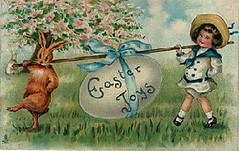
easterjoys
Originally uploaded by gaztrue.
HISTORY:
Today, Easter celebrates the resurrection of Jesus Christ. However, it has a long history dating back to pre-Christian times. The word Easter is derived from the Anglo-Saxon Goddess of Spring, Eostre. The festival of Eostre was held on the Vernal Equinox to celebrate new life. According to the New Testament, Jesus Christ was crucified of the eve of Passover and therefore the early Christians who grew up with a Hebrew tradition thought of Easter as a continuation of the Passover festival. Both the celebration of Eostre and Passover fell during the same time, thus early Christians, who were persecuted for their new beliefs, were able to celebrate Easter and spread their message slowly without too much detection or friction. By the second century, Easter was a well-established festival date. However, the Christians wanted to distinguish their celebrations from Passover. Thus, the Roman emperor, Constantine the Great, called the Council of Nicea in 325 to order. There it was established that Easter would become a moveable feast between March 21 and April 25 and so Easter would be celebrated on the first Sunday after the full moon of the Vernal equinox. However, if that Sunday coincided with Passover, Easter would be celebrated on the following Sunday.
Easter is not one day rather it is an entire season in the Christian calendar. It begins with Fat Tuesday/Mardi Gras, which is a day to really have fun before Lent. Ash Wednesday, the following day, is the day when Christians have a cross put on their foreheads with ash made from the palms of the previous year, a symbol of penitence and mortality, to show that they belong to the church. Ash Wednesday is the first day of the Lenten season. Lent, the forty-six days prior to Easter Sunday, is a period of penitence and fasting. Holy Week, the week that immediately precedes Easter, begins with Palm Sunday, which commemorates the day Jesus entered Jerusalem and the people celebrated by waving palm fronds. Maundy Thursday, the Thursday prior to Easter, commemorates Christ’s last supper (Eucharist). The next day is Good Friday and is the day Christ was crucified. Easter Sunday is the day Christ was resurrected from the dead. Early on Easter Sunday, the roman guards who were watching the tomb were struck by lightening by an Angel who then rolled back the stone of the tomb where Jesus lay. Later the guards came to their senses and found the tomb open and Jesus’ body was no longer there. They were told by their superior to say that the disciples had stolen the body while they slept. But, two angels appeared to two holy women and told them that Jesus had risen as he had prophesized. Later that day Jesus appeared to two of his disciples in the village of Emmaus. As soon as they recognized him, he vanished. The disciples returned to Jerusalem and told the apostles the story. Then he appeared to the apostles and ate with them. He told them that he had been sent by his Father from heaven to perform the task of offering his life for the sins of mankind. Jesus in turn gave the apostles the power over sin so that they too could forgive the sins of others. Jesus then vanished again. Jesus appeared the following Sunday to turn the unbelievers into believers and did so for the next forty days. Ascension, observed 40 days after Easter, marks the last day Christ appeared on earth and made his departure from earth. Pentecost, the 50th day after Easter, which falls on the 7th Sunday after Easter, celebrates the descent of the Holy Spirit on the Apostles. This day concludes the Easter season on the Christian calendar.
In Early America, Easter was not celebrated as a festival like it was in Europe but as purely religious day because the Puritans and Protestants did not believe in religious festivals. After the Civil War, Easter was celebrated like it was in Europe because the Presbyterians felt that it helped to inspire new hope in people. Now Easter Sunday has fully developed into a time to have fun, color eggs, eat chocolate bunnies, cook great food and gather friends and family around you.
SYMBOLS:
The Easter Lily: The Easter lily symbolizes Jesus Christ’s resurrection. It is specifically a white lily because white is a symbol of a new life that has become pure through resurrection.
The Easter Bunny: The hare was sacred to Eostre, the Anglo-Saxon goddess of spring. Rabbits, known for their fecundity, symbolized fertility and rebirth and were sacrificed to her during the spring, which also symbolized rebirth. Legend says that she changed a bird into a four-footed animal, thought to be a rabbit. The Germans, in the 1500’s, began using the rabbit as a symbol of Easter. They brought the image of the Easter bunny to American culture in the 1700’s. They made the first edible Easter bunnies from pastry and sugar in the early 1800’s.
The Easter Egg: Eggs have been dyed and exchanged as gifts for centuries before Easter; beginning with the Romans, Gauls, Persians, Egyptians and Chinese during springtime rituals as a symbol of rebirth of the earth after winter. As a Christian symbol, it has come to represent the tomb from which Christ rose from the dead and thus symbolizing the rebirth of man. According to Polish folklore, when the Virgin Mary was begging the Roman soldiers for compassion not to hang Jesus on the cross she was holding a basket of eggs and her tears fell on them and they turned into brilliant colors. Edward I, the king of England, ordered 450 eggs to be gold leafed for Easter gifts in 1290. Every Easter beginning in 1883, Faberge designed the most famous eggs for the Alexander, the Russian Czar to give to his wife Empress Marie. Armenians decorate hollow eggs with images of Christ and Mary. The Ukrainians and Polish dip the egg in wax then in dye then wax is painted over the areas where that color is to remain then dyed again. This process is repeated until the desired pattern is achieved. The Greeks exchange eggs dyed red to symbolize the blood of Christ. The Germans dye hollow eggs and hang them from trees and give green eggs on Maundy Thursday. Many other cultures have their own way to decorate the eggs too.
Reluctant Housewife Holidays Articles
Technorati Tags: Holidays, Easter

No comments:
Post a Comment